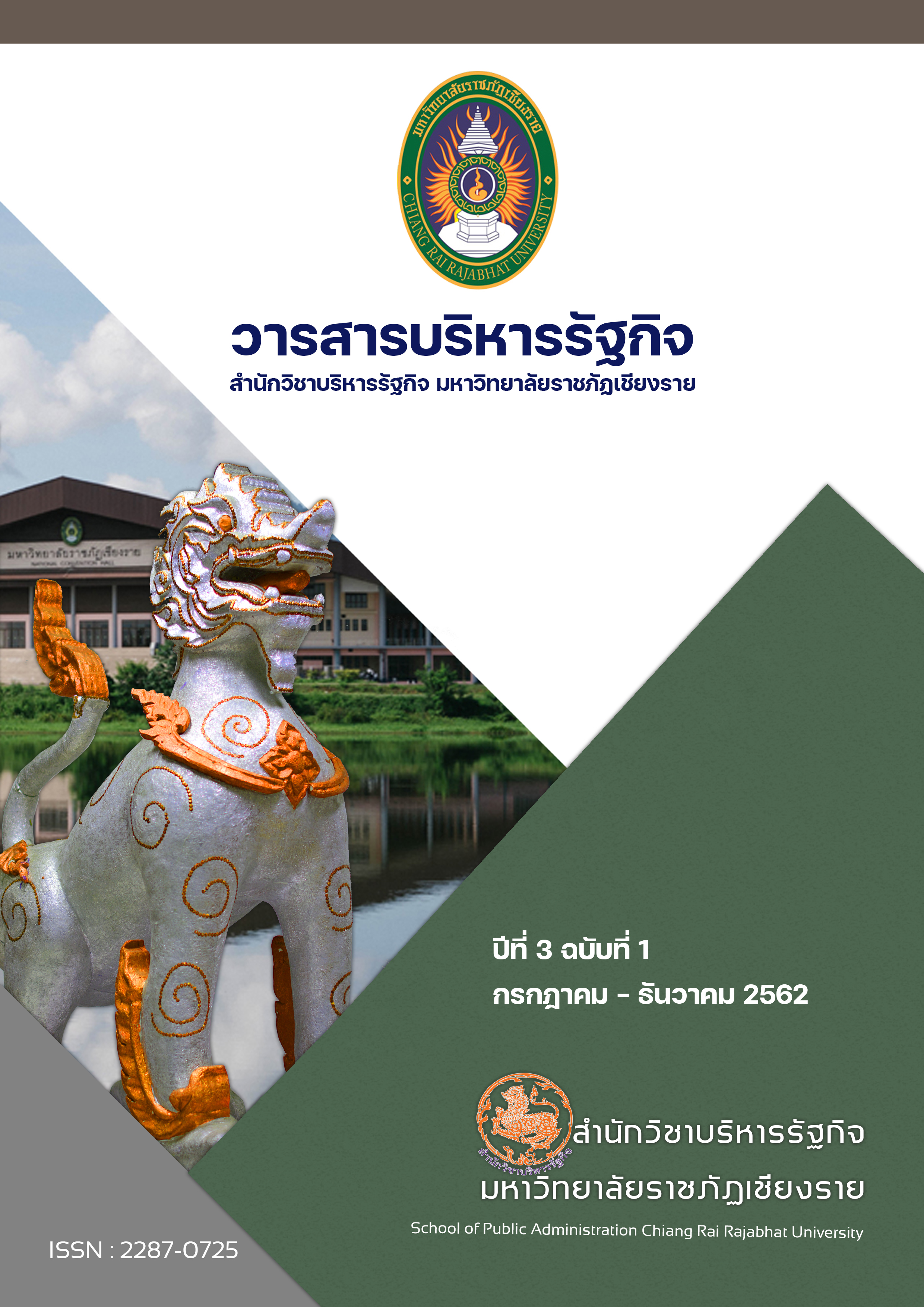The Influence of Transformational Leadership and Organizational Climate toward the Performance Efficiency of Personnel in Thongsuk College
Main Article Content
Abstract
The objective of this research was to study transformational leadership and organizational climate that influence the performance efficiency of personnel in Thongsuk College. The population in this research was its personnel of whom Yamane’s formula was applied to receiving a good representative for the population. The sample size was of 289 subjects with the confidence at 95% and error at ±5%. Questionnaire was adopted as a tool to conduct the research. The researcher selectively employed percentage, mean, t- distribution (T-test), f-distribution (F-test), and multiple regression analysis for statistical analysis. The results revealed that 1) although there were differences among personal variables including sex, status, education level, working position, and working experience affecting the performance efficiency of personnel in Thongsuk College, there was no statistically significant difference at 0.05, 2) Leadership factors of authority-compliance, laissez-faire, compromiser, and team management that were considered for predicting performance efficiency of personnel in Thongsuk College demonstrated a positive correlation in the same direction, and 3) factors of organizational structure, warmth and support, rewards and punishment, and performance standard that were considered for predicting performance efficiency of personnel in Thongsuk College demonstrated a positive correlation in the same direction.
Article Details
References
เกียรติคุณ วรกุล. (2545). ความสัมพันธ์ระหว่าง ภาวะผู้นำ แรงจูงใจใฝ่สัมฤทธิ์ และผลการปฏิบัติงานของหัวหน้างานระดับต้น ในโรงงานอุตสาหกรรมประกอบชิ้นส่วนอิเล็กทรอนิกส์. กรุงเทพฯ: มหาวิทยาลัยเกษตรศาสตร์
เฉลิมพงศ์มีสมนัย. (2556). Exploring Innovation 2nd edition. วารสารการจัดการสมัยใหม่, 11(1): 118-124.
จารุวรรณ ธนาวณิช. (2551). การรับรู้ภาวะผู้นำของผู้บริหารที่มีผลต่อประสิทธิภาพการทำงาน กรณีศึกษาเทศบาลนครลำปาง. ลำปาง: บริหารธุรกิจมหาบัณฑิต สาขาวิชาการจัดการทั่วไป มหาวิทยาลัยราชภัฏลำปาง.
บุญใจ ศรีสถิตย์นรากูร. (2553). ระเบียบวิธีการวิจัยทางพยาบาลศาสตร์. (พิมพ์ครั้งที่ 4). กรุงเทพฯ: ยูแอนด์ไอ อินเตอร์มีเดีย.
ประพันธ์ชัยกิจอุราใจ. (2558). ปัจจัยที่มีผลต่อพฤติกรรมการเป็นสมาชิกที่ดีขององค์การและประสิทธิภาพในการปฏิบัติงานของบุคลากรในกลุ่มอุตสาหกรรม. กรุงเทพฯ: วิทยาลัยการจัดการมหาวิทยาลัยศรีปทุม.
พรพรรณ สุนทรสุต และ ประจักร บัวผัน. (2554). บรรยากาศองค์การและการสนับสนุนจากองค์การที่มีผลต่อการปฏิบัติงานตามสมรรถนะหลักของพยาบาลวิชาชีพในโรงพยาบาลชุมชน จังหวัดอุดรธานี. วารสารวิจัย มหาวิทยาลัยขอนแก่น. 16(5): 551-562.
พัฒนชัย กุลสิริสวัสดิ์. (2551). การเตรียมองค์กรเพื่อรับการตรวจประเมินตามแนวทาง TQA. กรุงเทพฯ: สถาบันเพิ่มผลผลิตแห่งชาติ.
พิชิต เทพวรรณ์. (2548). บทบาทการบริหารทรัพยากรมนุษย์ของธุรกิจในประเทศไทยกับกลยุทธ์ Six Sigma. วารสารวิชาการมนุษยศาสตร์และสังคมศาสตร์ มหาวิทยาลัยบูรพา. 13(19): 66-81.
วิทยาลัยทองสุข. (2561). เอกสารบุคลากรวิทยาลัยทองสุข. กรุงเทพฯ.
วุฒิไกร เถยสูงเนิน. (2549). ภาวะผู้นำของผู้บริหารที่มีผลต่อประสิทธิผลของงาน ของพนักงานสาขาธนาคารไทยพาณิชย์ จำกัด (มหาชน) สำนักงานเขตพื้นที่วิสุทธิกษัตริย์. กรุงเทพฯ: บริหารธุรกิจมหาบัณฑิต สาขาวิชาการจัดการ มหาวิทยาลัยราชภัฏสวนสุนันทา.
อรัญญา ไชยศร. (2556). ความสัมพันธ์ระหว่างบุคลิกภาพ บรรยากาศขององค์การ ความผูกพันต่อองค์การกับพฤติกรรมการเป็นสมาชิกที่ดีขององค์การของครูโรงเรียนอาชีวศึกษาเอกชนในจังหวัดนครศรีธรรมราช. นครศรีธรรมราช: บริหารธุรกิจมหาบัณฑิต สาขาวิชาบริหารธุรกิจ วิทยาลัยเทคโนโลยีภาคใต้.
อลงกรณ์มีสุทธา และ สมิต สัชฌุกร. (2545). การประเมินผลการปฏิบัติงาน. กรุงเทพฯ: สมาคมส่งเสริมเทคโนโลยี(ไทย-ญี่ปุ่น).
Allen, N. J. , & Meyer, J. P. (1990). A three-component conceptualization of organizational commitment. Human Resource Management Review. Volume 1, Issue 1, Spring 1991, 61–89.
Bass, B. M., Waldman, B., Avolio, B. J., & Bebb, A. S. (1987). Improving Organization Effectiveness Through Transformational Leadership. California: Sage.
Bennis W. and Nanus B. (1985). Leaders : The strategies for taking change. New York: Harper and Row.
Chaikidurajai, P. (2015). Factor Affecting Organization Citizenship Behaviors and Performance Efficiency of Staff in Industry group. Bangkok : Graduate college of Management Sripatum University.
Chaisorn, A. (2013). The Relationship between Personality, Organizational Climate, Organizational Commitment and Organizational Citizenship Behaviors of Private Vocational School Teachers in Nakhon Si Thammarat. Nakhon Si Thammarat : Master of Business Administration, Gradute School, Southern College of Technology, Nakhon Si Thammarat.
Kunsiriwat, P. (2008). Preparation of an organization for auditing in accordance with TQA guidelines. Bangkok : Thailand Productivity Institute.
Litwin, G. H., & Burmeister, M. G. (1992). Climate Performance. New York: The Purrington Foundation.
Litwin, G.H., & Stringer, R.A. (1968). Motivation and Organizational Climate. Boston: Division of Research Harvard Business School.
Meesuttha, A. and Sutchukorn, S. (2002). Performance Evaluation. Bangkok : Technology Promotion Association (Thailand-Japan).
Misomnai, C. (2013). Exploring Innovation 2nd edition. Modern Management Journal. Vol. 11 No.1 (January-June 2013). P.118-124.
Robbins and Coulter. (2007). Organization Theory: Structure, Design, and Applications. New Jersey: Prentice-Hall.
Srisatitnarakun, B. (2010). The Methodology in Nursing Research. Bangkok : You and I Intermedia Ltd.
Suntornsut, P. and Bouphan, P. (2011). The Influence of Organizational Climate and Organizational Support on the Core Competency of Registered Nurses in the Community Hospitals of the Udon Thani Province. Konkhan : Konkhan Research Journal Vol. 16 No.5. p. 551-562.
Tanawanich, J. (2008). Administrator’ Leadership Perception that Effects Working
Efficiency : Case Study Nakhon Lampang Municipality. Lampang : Master of Business Administration (General Management) Lampang Rajabhat University.
Thepwan, Phichit. (2005). Human Resource Management Roles of Business in Thailand and Six Sigma Strategy. Chonburi : Human and Social Journal Burapha University. Vol.13 No.19 (September-December). P.66-81.
Thongsook College. (2018). Personnel Documents : Bangkok.
Thoeysoonnoen, W. (2006). Leadership of Managers Influencing Work’s Employees of Siam Commercial Bank Public Company Limited, Witsukasat Area Office. Bangkok : Master of Business Administration (General Management) Suan Sunandha Rajabhat University.
Worakun, K. (2002). Relationships between leadership, achievement motivation and the performance of the head supervisor in the electronics assembly industry. Bangkok : Kasetsart University.
Yamane. (1967). Taro Statistic : An Introductory Analysis. New York: Harper &row.


